
FRANCESCA WOODMAN, OR THE SHADOW OF SUICIDE
Richard Jonathan
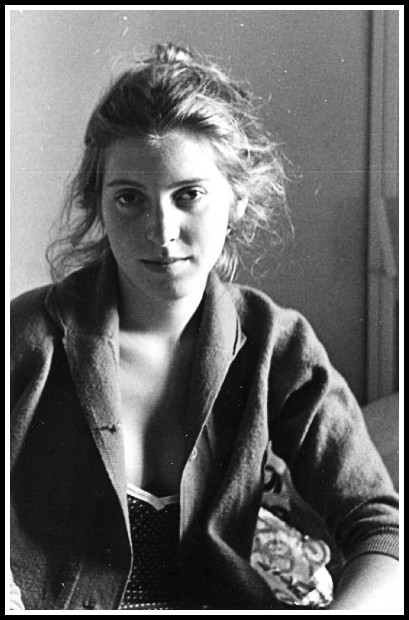
Francesca Woodman, 1979
The terrible thing about dying is that you can only do it once.
Alberto Giacometti, interview in Qu’est-ce qu’une tête? Film by Michel Van Zele (ARTE France-Les Films d’ici, 2000) DVD
Everything pertaining to play once pertained to the realm of the sacred.
Giorgio Agamben, Infancy and History: On the Destruction of Experience, trans. Liz Heron (London: Verso, 2007), p. 79
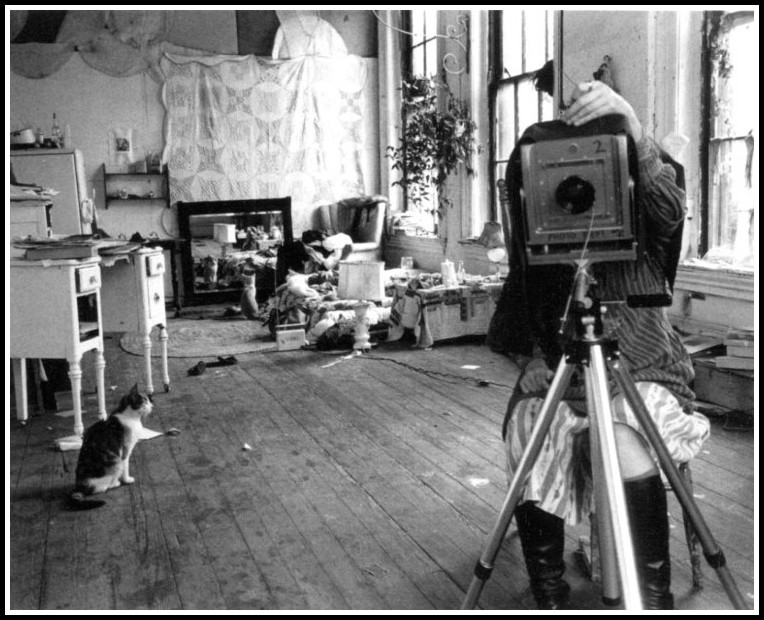
Francesca Woodman in her studio, Providence (Rhode Island), 1976 | Photo: George Lange
Wherein lies the allure of Francesca Woodman’s photographs? What accounts for their bewitching power? A veritable cottage industry of criticism has arisen in an attempt to respond to these questions. From art history (surrealism) to biography (suicide at twenty-two), from feminism (vicissitudes of subjectivity) to philosophy (the Kantian sublime), critics and commentators have spared no effort in a bid to honour this artist and shed light on her work. However worthy much of this criticism may be, my gut tells me that only a work of art infused with the spell Francesca casts can truly honour her. I attempted this in my novel Mara, Marietta. Here, then, I will take a different tack, throwing my essayist’s hat into the critics’ and commentators’ ring, and try to approach the work through the woman, the life through the death.
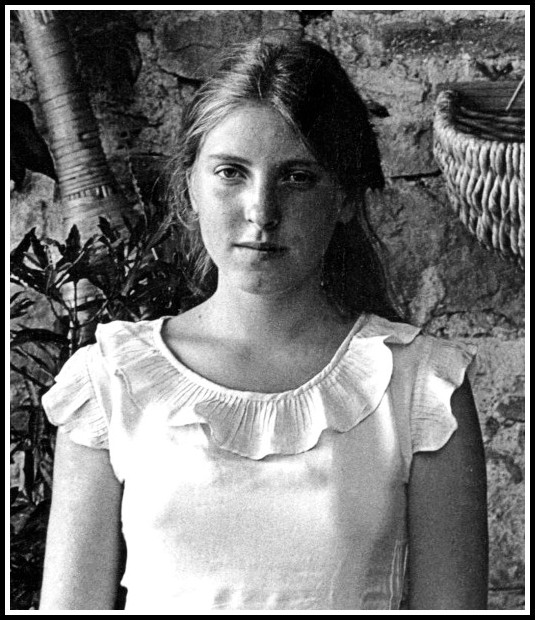
Francesca Woodman at 13, Antella (Italy), 1971 | Photo: George Woodman
Perhaps the most salient characteristic of Fancesca’s work is its ‘disquieting mischief’. If ‘mischief’ is ‘a playful inclination to tease or disturb’, ‘disquieting’ intensifies the teasing and disturbing, introducing the notion of the uncanny: the return of the repressed, whether triggered by repetitions, doubles or blurred boundaries between life and death. All these elements of the uncanny are found in Francesca’s work. Indeed, photograph after photograph stages a confrontation—between motion and immobility, absence and presence, animate and inanimate; mirror and flesh, image and text, serenity and sex—in order to evoke the uncanny. She turns dilapidated rooms into sacralized space, a place for the performance of adolescent rituals, games of hide-and-seek with identity, games in which you go from chaos to cosmos and back.
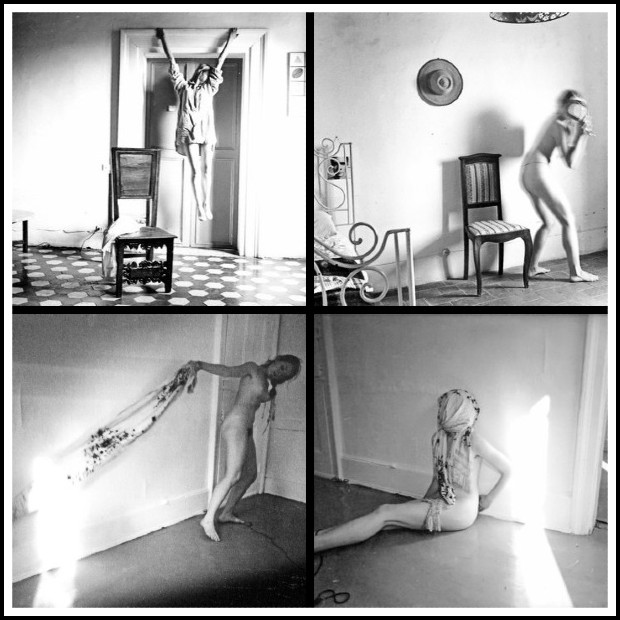
Francesca Woodman, Untitled | Top: Rome/Antella, 1977-78 | Bottom: New York, 1979
To this adolescent obsession with metamorphosis—wherein the body is the vector for seizing the fluctuations of the self and appropriating the world—her images owe their uncanny quality. As for our bewitchment, our fascination with Francesca, it largely derives from the conjunction of her personal risk-taking and her mastery of image-making, of her emotional turmoil and her artistic control. On one side, the obsessive concerns of adolescence; on the other, the calm maturity of her artistic vision. On one side, the present body where past and future battle, where the quest to find affiliation takes place; on the other side, an unfailingly effective, fully realized (not ‘experimental’) aesthetic. It is the conviction with which Francesca engaged in her struggles that accounts for her compelling images; in other words, it is her ethics of authenticity that gave birth to her aesthetic. In this, be it said in passing, she is like Rimbaud.
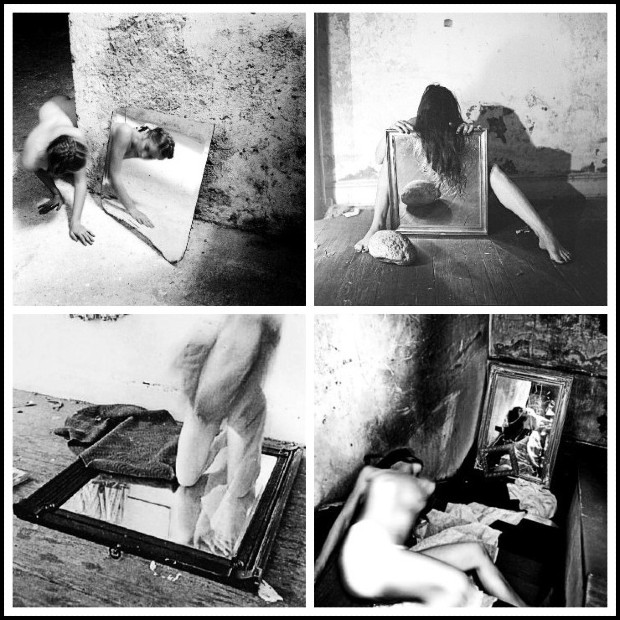
Francesca Woodman: Top: Self-deceit #1, Rome 1978 | ? | Bottom: Untitled, 1975-76 | ?
Francesca’s images, however often they may be ‘mechanically reproduced’, maintain their ‘aura’, that stamp of aesthetic authority of which Walter Benjamin spoke. There’s more to that aura, however, than the halo of the artist’s hands: hovering over the images we also discern the aura of death. ‘Back projection’, many critics would object, ‘the work must be considered independently of the life’. That’s a valid point of view. Indeed, as I have argued, Francesca’s work stands on pillars of Athenian calm, even if they are reflected in pools of Dionysian turmoil. For my part, however, I cannot ignore the Dionysian pools; indeed, if between Tolstoy and Dostoevsky I would not want to choose, if I had to, I’d pick the epileptic over the aristocrat, Crime and Punishment over War and Peace. Unapologetically, then, I will now try to shed some light on the shadow of suicide that hovers over Francesca’s images.
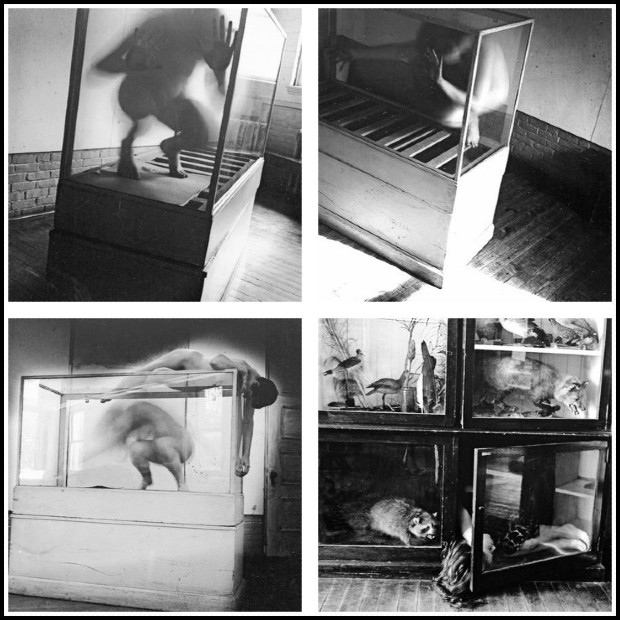
Francesca Woodman, Providence, 1975-76: 1,2,3: Space 2 | 4: Untitled

FRANCESCA WOODMAN – JOURNAL
1 – Francesca’s Journal : … book bought on a sweltering hot day in August ’73 in the hope that it will work out…
2 – I don’t know if it will because when I think of things instead of just letting them happen they usually turn out different
3 – or don’t turn at all
Scott Willis’ film, The Woodmans (2011), is indispensable viewing for anyone who hopes to gain a deeper understanding of Francesca. It features extracts from her diaries, and interviews with her parents, brother, friends and others who knew her. In the mirror of this circle each of us will try to place the square of Francesca’s suicide; thanks to Scott Willis and his interviewees, however we do it, we will do it with dignity.
In this essay, all quotations by and about Francesca are transcribed from the DVD of The Woodmans.
On 19 January 1981, Francesca threw herself to her death from the roof of a public building near her Manhattan apartment. She was twenty-two years old, two and a half months shy of twenty-three. ‘She just emotionally fell apart. I don’t know why’, said her mother, Betty. ‘She felt she was a very good artist, that she had a very good body of work and she should be recognized. She had something to say, and why weren’t people listening?’. Her father George pointed out that since September 1980 she’d been ‘very distressed’. On 19 January 1981 she’d had ‘a crappy day’: She’d learned that the National Endowment for the Arts grant she’d applied for had been refused, and found out that her bicycle had been stolen. She’d called several people, but couldn’t reach any of them. Her psychotherapist phoned her father to express his concern that she’d missed her appointment. Later that day, the police, having identified Francesca by the clothes she was wearing, reported her death to her parents. Monday. Winter. New York.
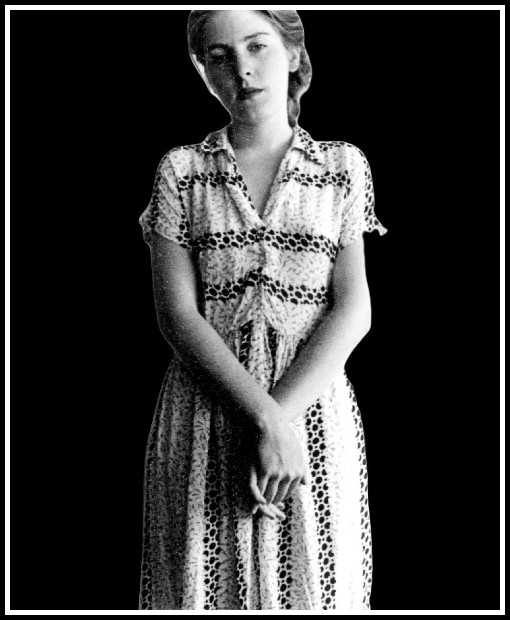
Francesca Woodman, Untitled, 1980
Francesca had attempted to kill herself before. The firemen had to break down the door of her apartment and take her to hospital. She wrote to her closest friend, Sloane Rankin: ‘Dear Sloe Plum, after weeks and weeks and weeks of thinking about it, I finally managed to try to do away with myself as neatly and concisely as possible. I do have standards. My life at this point is like very old coffee sediment. I would rather die young, leaving various accomplishments, some work, my friendship with you and some other artefacts intact instead of pell-mell erasing all these delicate things.’

FRANCESCA WOODMAN – JOURNAL
I see myself this fall piddling past each day | I don’t know if I can do another year of dishonesty
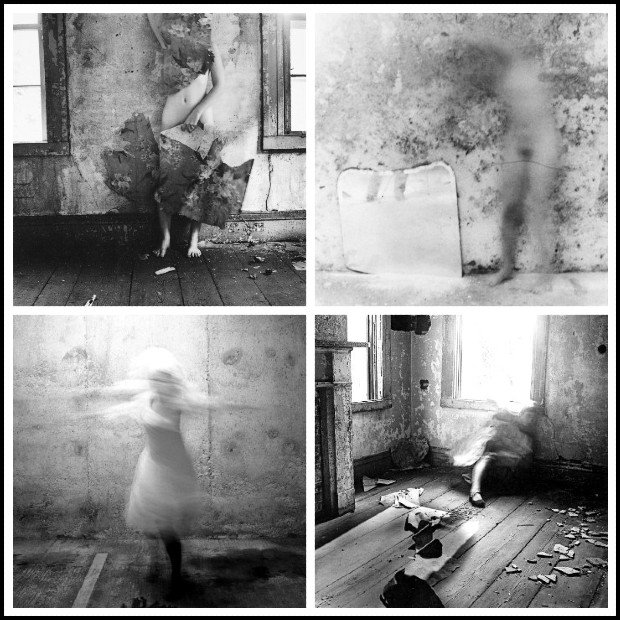
FRANCESCA WOODMAN
Top: Space 2, 1977| Self-deceit #7, 1978 | Bottom: Self-deceit #?, 1978 | House #?, 1976
Francesca had tried to get her work shown in New York. She was told to come back in a few years. She’d tried to break into fashion photography. Her vision of fashion was too ‘avant garde’.
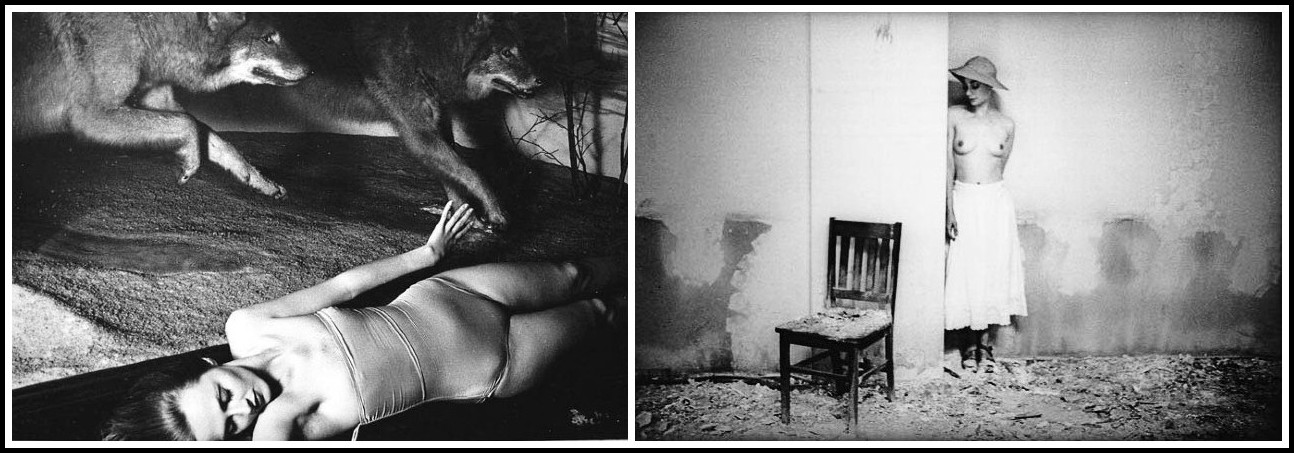
Francesca Woodman, 1 & 2: Untitled, 1979-80
Sloane was alarmed when Francesca told her she’d stopped making images. Her diary entries around this time include: ‘I do not want to read, draw, talk or see tonight. I hope this doesn’t last long.’ … ‘This evening I am so pleased. Real things don’t frighten me, just the ones in my mind do.’ …. ‘This is the fifth night I have not been able to sleep. I think when I come down from the insomnia high I will be disappointed in myself. The effort to do away with this attitude in my work has had strange effects on my life.’ … ‘It is that life as lived by me now is a series of exceptions. I was (am?) not unique but special. This is why I was an artist. I was inventing a language for people to see the everyday things that I also see and show them something different. Nothing to do with not being able “to take it” in the big city or with self-doubt or because my heart is gone. And not to teach people a lesson. Simply the other side.’

FRANCESCA WOODMAN – JOURNAL
1 – I feel like I am floating in plasma | I need a teacher or a lover | I need someone to risk being involved with me
2 – I am so vain and I am masochistic. How can they coexist?
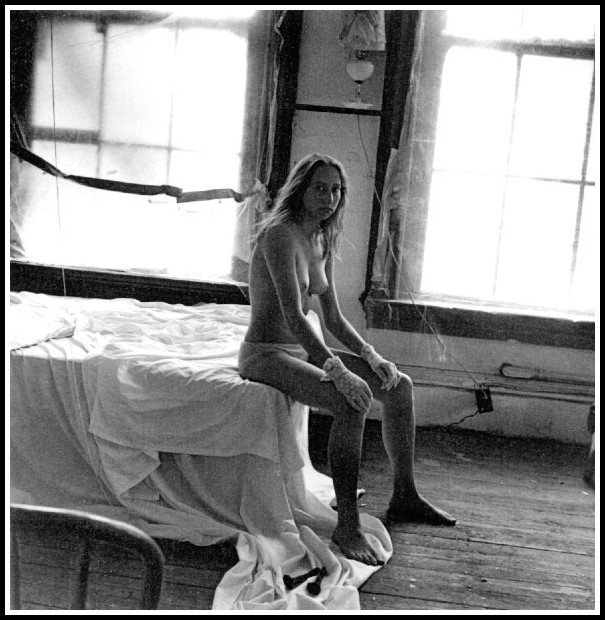
Francesca Woodman, Depth of Field 2, Providence 1976
Betty Woodman (d. 2 January 2018) was a ceramic artist whose work has received fairly high-profile recognition. George Woodman (d. 23 March 2017) was a painter who took up photography after Francesca committed suicide. A selection of his paintings was shown in a group exhibition at the Guggenheim that opened days after his daughter died. Both Francesca’s parents, then, were artists. Scott Willis’ interviews with them are very revealing; indeed, his documentary is a very good ‘portrait of the parent as an artist’. So, in trying to assume her genealogy, to take up her place in a line of affiliation—as every adolescent, in order to become an adult, must—Francesca needed recognition: her own reflection in a mirror was no longer enough. In New York, as Sloan Rankin put it, Francesca ‘didn’t fit in’: recognition was elusive.

FRANCESCA WOODMAN – JOURNAL
1 – I’m always awkward around these things | My parents are so very married | and so verily happy so
2 – I don’t know want them to see | or have any part in what I am doing
3 – I don’t know what it is | since they are fairly supportive | I don’t know we get along well
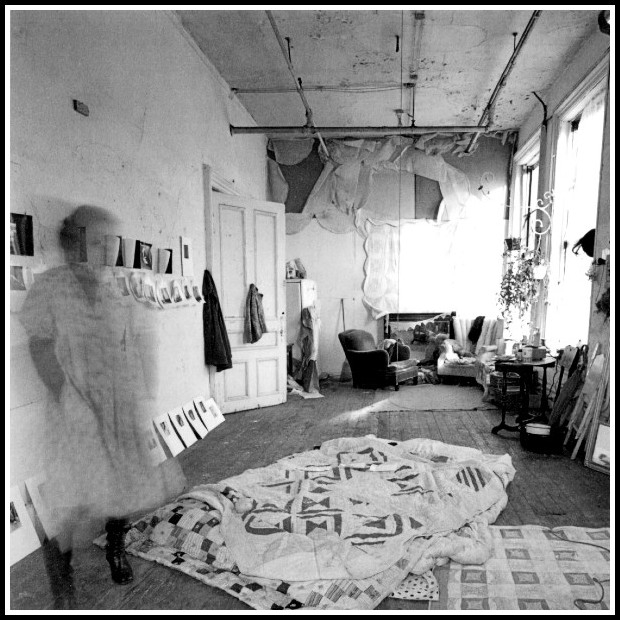
Francesca Woodman, Studio in Providence, 1976-77
In Rome, however, where Francesca lived from May 1977 to August 1978, she did ‘fit in’, she did receive a certain recognition. Isabella Pedicini has written eloquently about this period in her life.
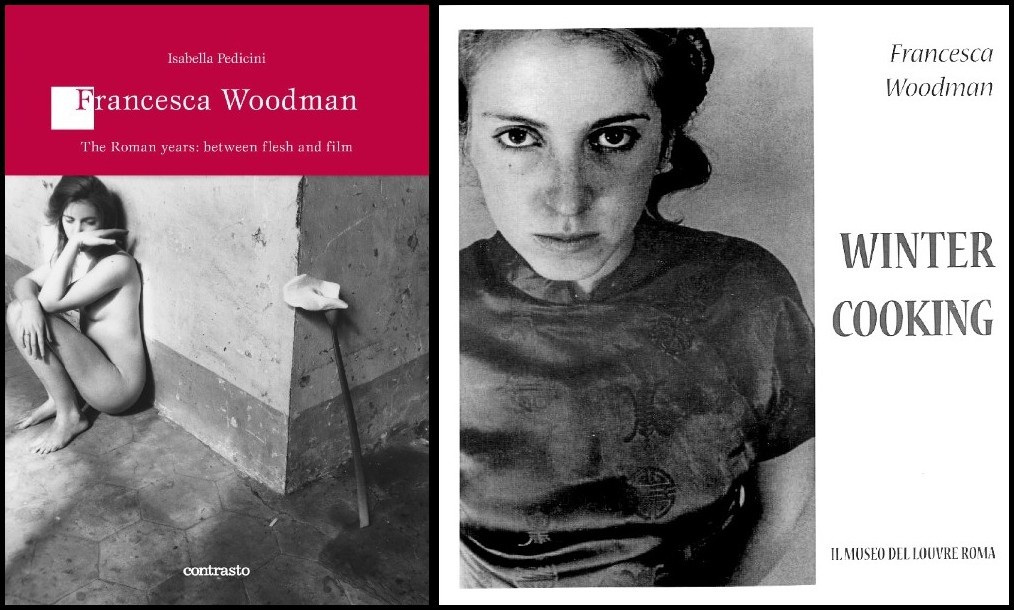
Isabella Pedicini, Francesca Woodman: The Roman Years | Francesca Woodman, Winter Cooking
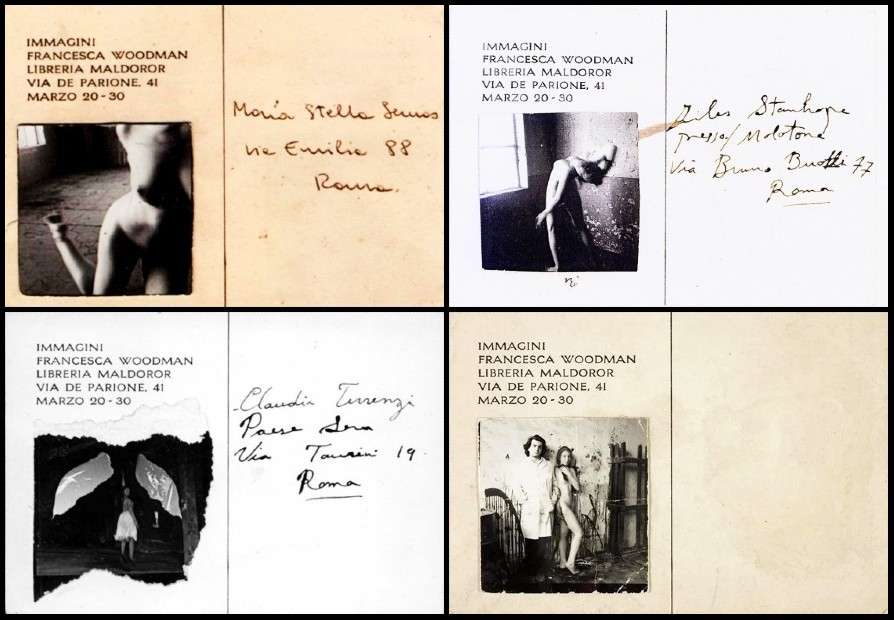
Francesca Woodman, Exhibition Invitation Cards, Rome 1978
Francesca never quite managed, then, to find her place in her genealogy. Sex might have helped her to do so. After all, a sustained, satisfying sexual relationship is the foundation of individuality, marking as it does a reset of one’s relations with one’s parents. On this score, Sloan Rankin had this to say: ‘She had incessant sexual attempts. It was sad that it was something she did that didn’t have an emotional meaning beyond the fact that it might have worked itself into a photograph a little bit’.

FRANCESCA WOODMAN – JOURNAL
1 – Why don’t I tell him? Finally in bed I hold him and he cried and I felt pity and then I felt revulsion at his weakness
2 – my sexuality isn’t as strong as it once was | I have to feel sure of being desired | not just tolerated
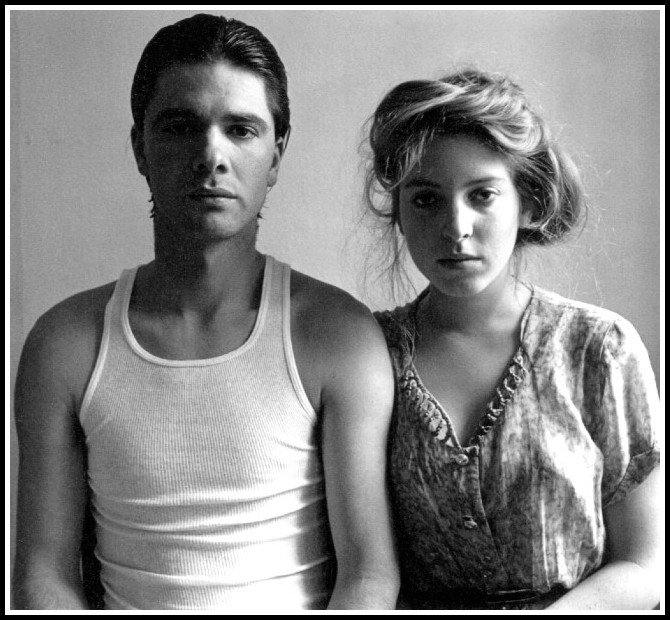
Francesca Woodman, Untitled, Rome 1977-78
Inside a lupine rosette, a snowflake / Saxifrage spreads a cloth of gold / orchids defy ice / Look! Lichen-freckled boulders shelter fossils / And now a new solitude overcomes you / Trauma freezes time / irradiating absence with unknowing / Only desire moves, refusing to concede / never can two be one
‘Isolation’ – An acrostic for Francesca by Richard Jonathan

FRANCESCA WOODMAN – JOURNAL
1 – I am happy except when he treats me like vermin or when he acts like my sexuality is a pain in the neck
2 – and then at 2 in the morning he looks up at my pictures and says he doesn’t see what that has to do with art anyway
When her demons became too insistent, Francesca decided on radical action: She who so often had figured movement in her photos would now seek not only stillness, but the eternal. She would build a temple, freeze time, and thereby shut her demons out; in the inorganic, she would tranquilize herself.
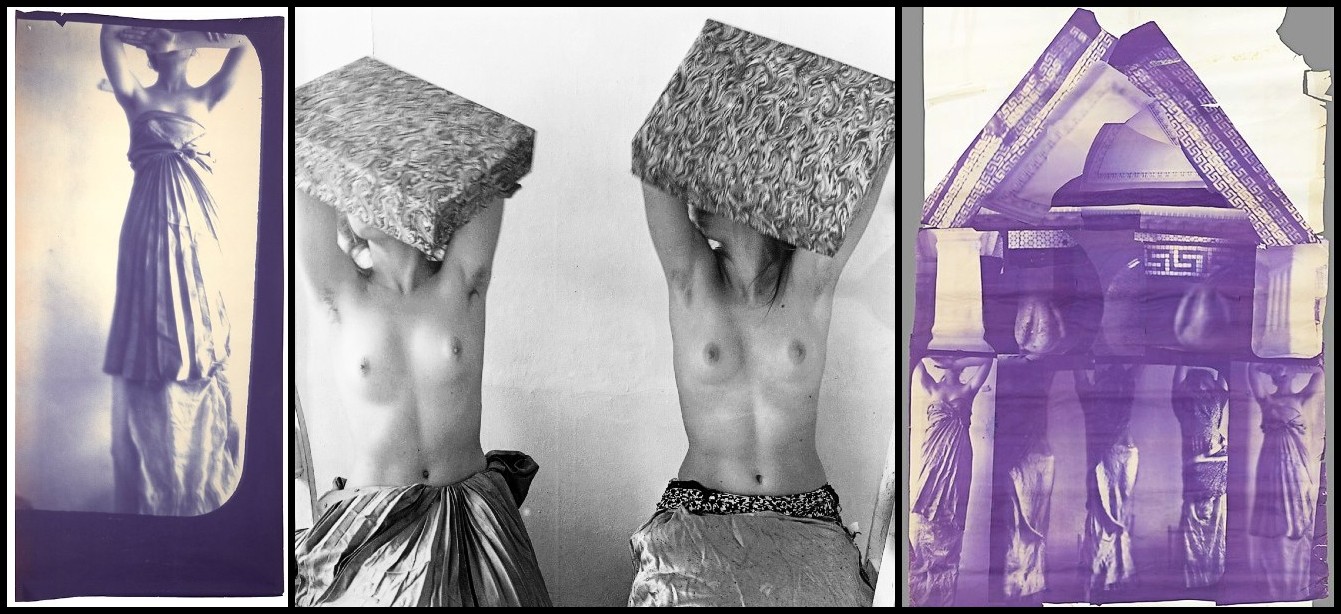
FRANCESCA WOODMAN
Caryatid (Study for Temple Project), 1980 | Untitled, 1979-80 | Blueprint for a Temple, 1980
Just as in sex where a singular intimacy implying a real relation eluded her…
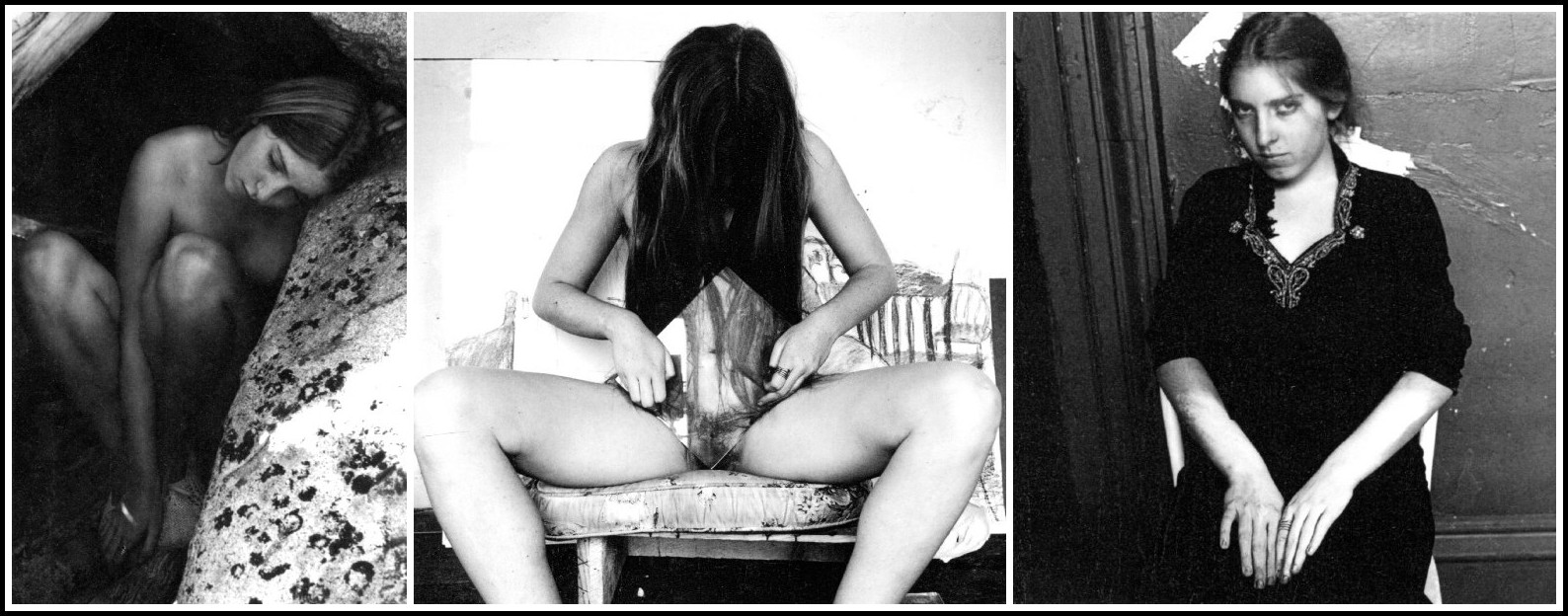
Francesca Woodman, 1, 2 & 3: Untitled | Boulder, 1972-75 | Providence, 1976 | New York, 1979-80
… so a temple promising eternity and refuge from the Furies proved illusory: she could not turn herself to stone.
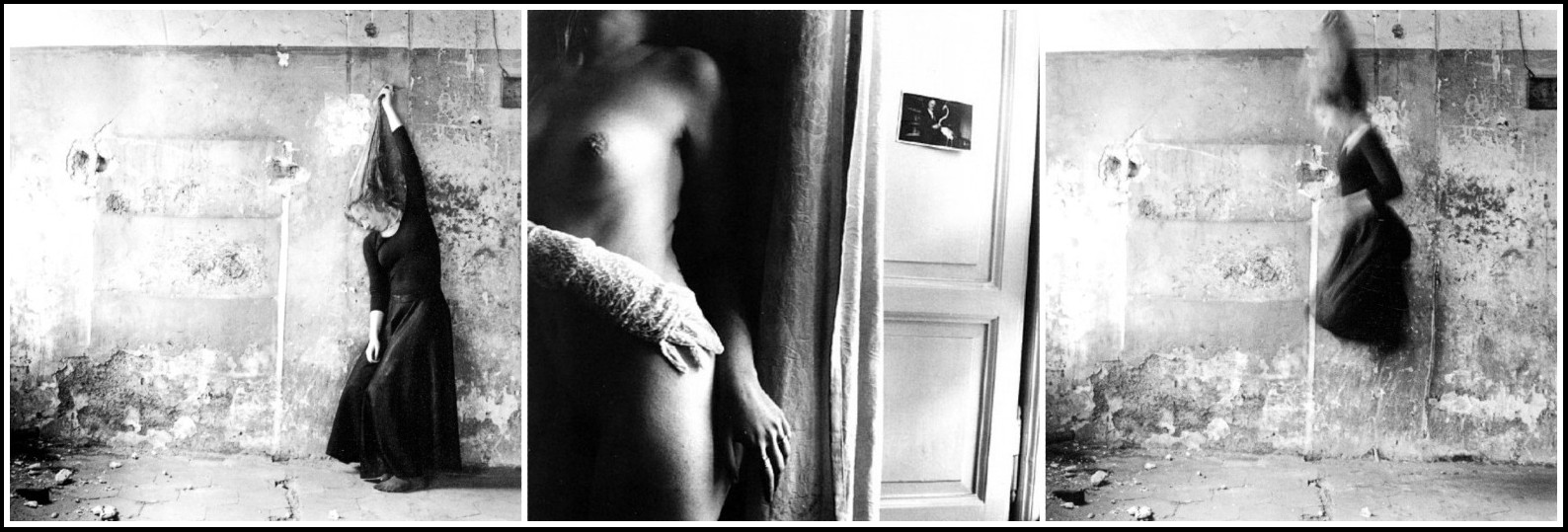
Francesca Woodman, 1,2,3: Untitled, Rome, 1977-78
Death offered her a way out of the impasse.

FRANCESCA WOODMAN – JOURNAL
1 – Last Francesca Journal Entry | Jan. 19, 1981
2 – This action that I foresee has nothing to do with melodrama
In Francesca’s case, it would seem, the sublimating function of art was fatally short-circuited, making her ideal of artistic purity tyrannical. In the sovereign sphere of her art, in the sidereal realm where she broke down and cried, what angel was there to hear her? None. Just as down here, among the mortals, there was no-one. Lacking recognition, her proud isolation overcome by radical loneliness, she felt the chill chafing of a hand reaching out to her. She took it: The hand of death is always cold.
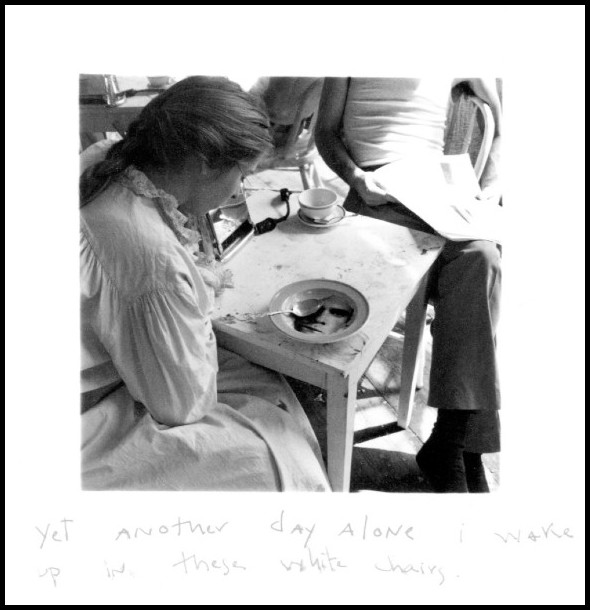
Francesca Woodman, Stanwood (Washington), 1979
‘Yet another day alone – I wake up in these white chairs.’
FRANCESCA WOODMAN – 3 APRIL 1958 – 19 JANUARY 1981
‘Today I came from Newport, seething with ideas and a new hat.’
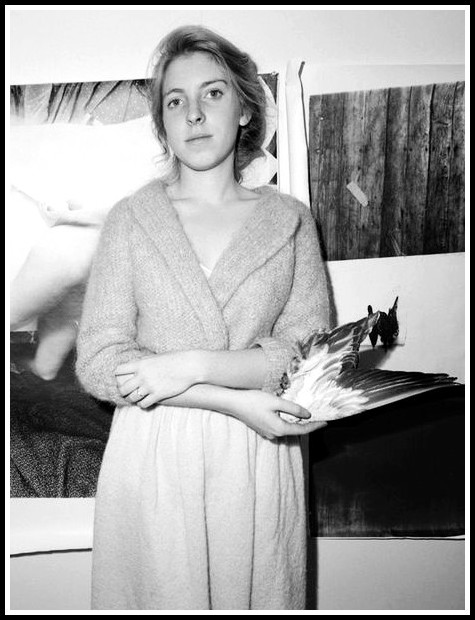
Francesca Woodman in her studio, 1978
MARA, MARIETTA: A LOVE STORY IN 77 BEDROOMS – READ THE FIRST CHAPTER
A literary novel by Richard Jonathan
Richard Jonathan, Mara, Marietta: A Love Story in 77 Bedrooms – Read the first chapter
TWO ACROSTICS FOR FRANCESCA WOODMAN
Richard Jonathan
AN ATTEMPT AT SILENCE
Richard Jonathan
Abeyance, the fall of a snowflake;
New-minted world, virgin.
A face in a mirror,
The slither of a serpent,
The flow of sand in an hourglass.
Erasure, interstice, absence.
Moth’s wing, soft smoothness;
Petals falling from a dry stem,
The floating of a feather.
Alabaster, an egg in moonlight;
Talcum under a wedding dress.
Shrouded furniture,
Islands from the air;
Lovemaking while children wakeful.
Ellipsis, interval, caesura.
Night summoning nakedness,
Communion wafer:
Eternity, stars.
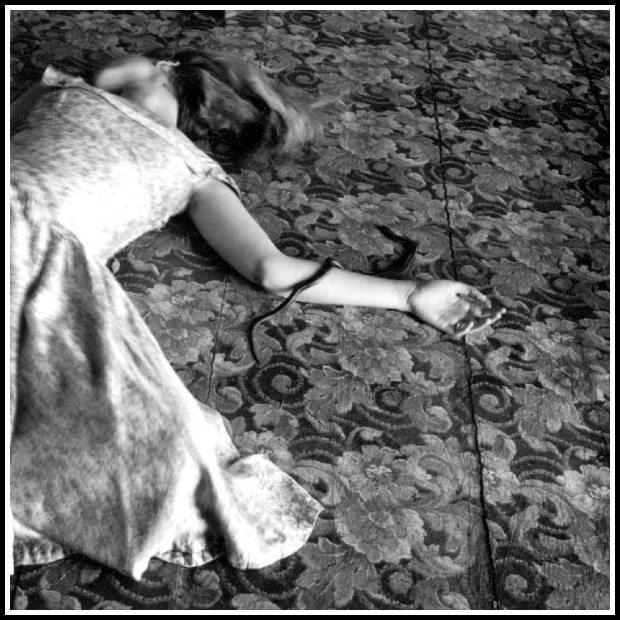
Francesca Woodman, Untitled, 1975-78
A MOMENT OF STILLNESS
Richard Jonathan
A skeleton of leaf, scorched and charred.
Mystery, where the light nests.
Only, ever, always
Mourning, thickening the darkness.
Eclipse,
Negation;
The residue of a life.
Obliterated spoors, husks of needs:
Forgotten.
Serried rows of spectators,
The public burning of a heretic.
Incessant downfall,
Landslip, scree, stones—
Lapidary torture.
Nexus of scarecrows.
Exclusion,
Surcease: No
Spital-house bed, but deliverance.
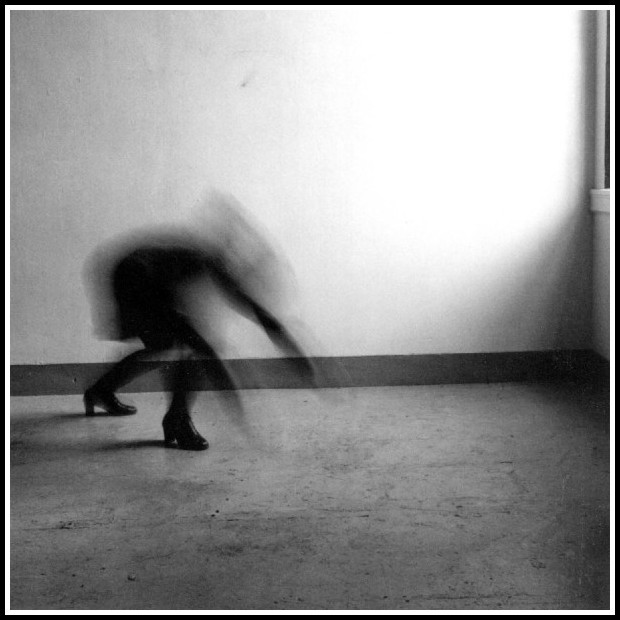
Francesca Woodman, Space 2, 1976
MARA, MARIETTA: A LOVE STORY IN 77 BEDROOMS
A literary novel by Richard Jonathan
FRANCESCA WOODMAN | PATTI SMITH
REDONDO BEACH
Patti Smith
Late afternoon, dreaming hotel
We just had the quarrel, sent you away
I was looking for you, are you gone, gone
Called you on the phone, another dimension
Well you never returned, oh you know what I mean
I went looking for you, are you gone, gone
Down by the ocean, it was so dismal
Women all standing with shock on their faces
Sad description, oh I was looking for you
Everyone was singing, girl is washed up
On Redondo Beach and everyone is so sad
I was looking for you, are you gone, gone?
Pretty little girl, everyone cried
She was the victim, of sweet suicide
I went looking for you, are you gone, gone
Down by the ocean it was so dismal
Women all standing with shock on their faces
Sad description, oh I was just looking for you
Desk clerk told me, girl was washed up
Was small, an angel, with apple blonde hair, now
I went looking for you, are you gone, gone
Picked up my key, didn’t reply
Went to my room, started to cry
You were small, an angel, are you gone, gone
Down by the ocean it was so dismal
I was just standing with shock on my face
The hearse pulled away and the girl that had died, it was you
You’ll never return into my arms ‘cause you were gone, gone
Never return into my arms ‘cause you were gone, gone
Gone, gone; gone, gone; goodbye
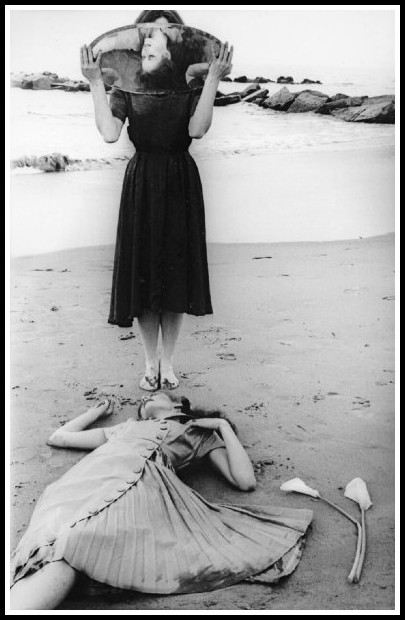
Francesca Woodman, Untitled, 1975-78
PATTI SMITH ON ‘REDONDO BEACH’
The words for ‘Redondo Beach’ were written in 1971. I was sharing a space near the Chelsea Hotel with Robert [Mapplethorpe] and my sister Linda. One afternoon I had a rare argument with my sister and she left. She didn’t return and by nightfall I was worried. Needing time to think, I took an F train to Coney Island and sat on the littered beach until the sun rose. I came back, wrote the draft and fell asleep. When I awoke, she had returned. I showed her what I had written and we never quarreled again.
Patti Smith, Patti Smith Complete: Lyrics, Notes and Reflections (NY: Anchor Books, 1999)
BETSY BERNE ON FRANCESCA WOODMAN
‘She was kooky, and at first I didn’t want to be anywhere near her,’ says her friend, writer and journalist Betsy Berne. ‘We were in the same dorm, and I couldn’t get away from her. She seemed to have been born in the wrong century – she was totally outside pop culture; she never watched TV; she couldn’t have cared less about music.’
Rachel Cooke, ‘Searching for the real Francesca Woodman’, The Guardian, 31 August 2014

Patti Smith | Robert Mapplethorpe
ELEGIE
Patti Smith
I just don’t know what to do tonight
My head is aching as I drink and breathe
Memory falls like cream in my wounds, moving on my own
There must be something I can dream tonight
The air is filled with the moves of you
All the fire is frozen yet still I have the will
Trumpets, violins, I hear them in the distance
And my skin emits a ray, but I think it’s sad, it’s much too bad
That our friends can’t be with us today
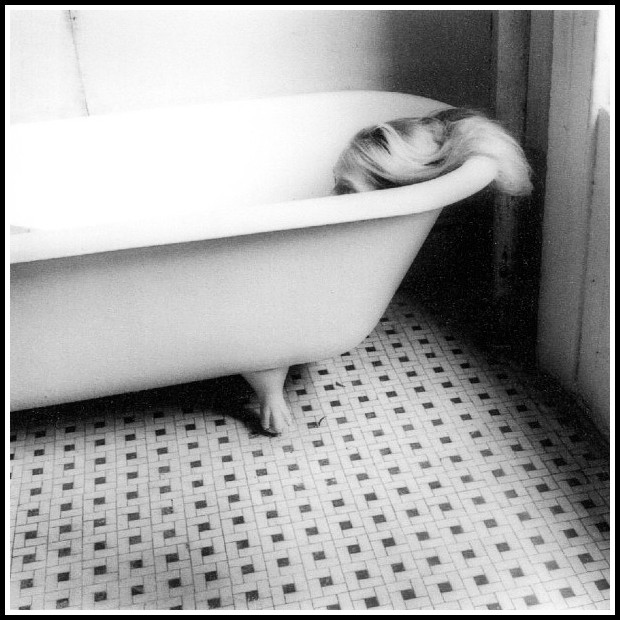
Francesca Woodman, Untitled, 1979-80
By Richard Jonathan | © Mara Marietta Culture Blog, 2023 | All rights reserved
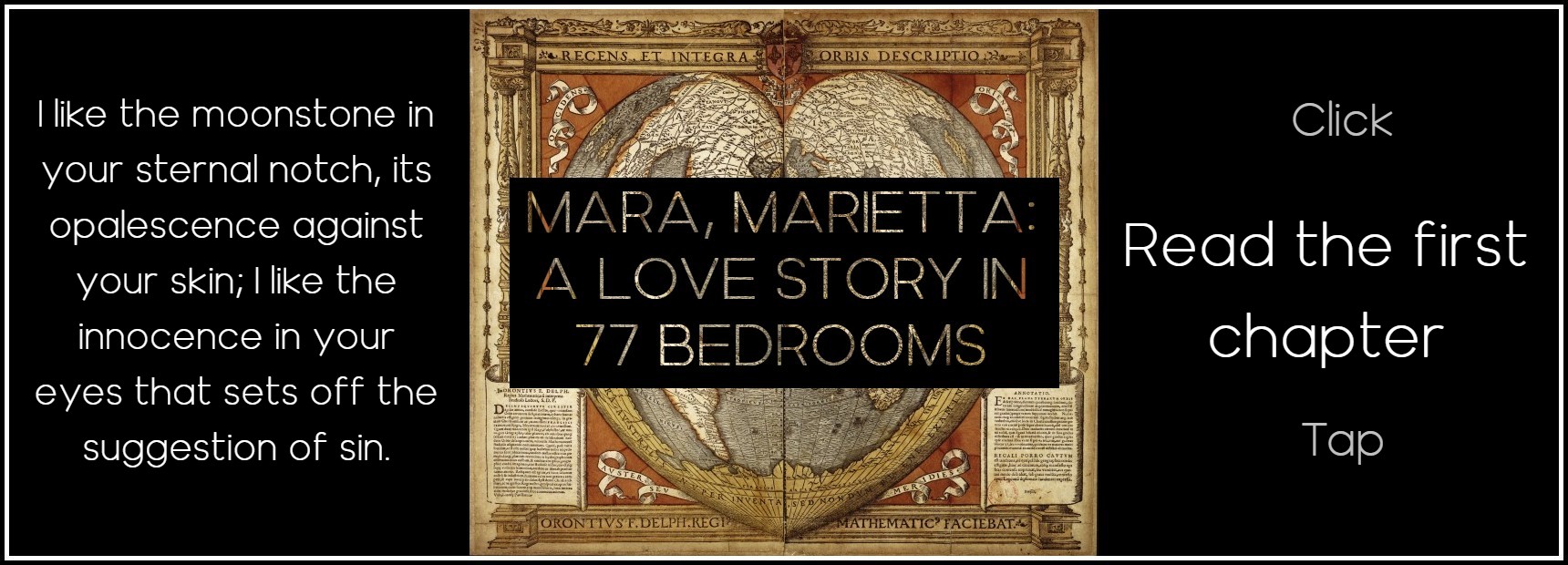

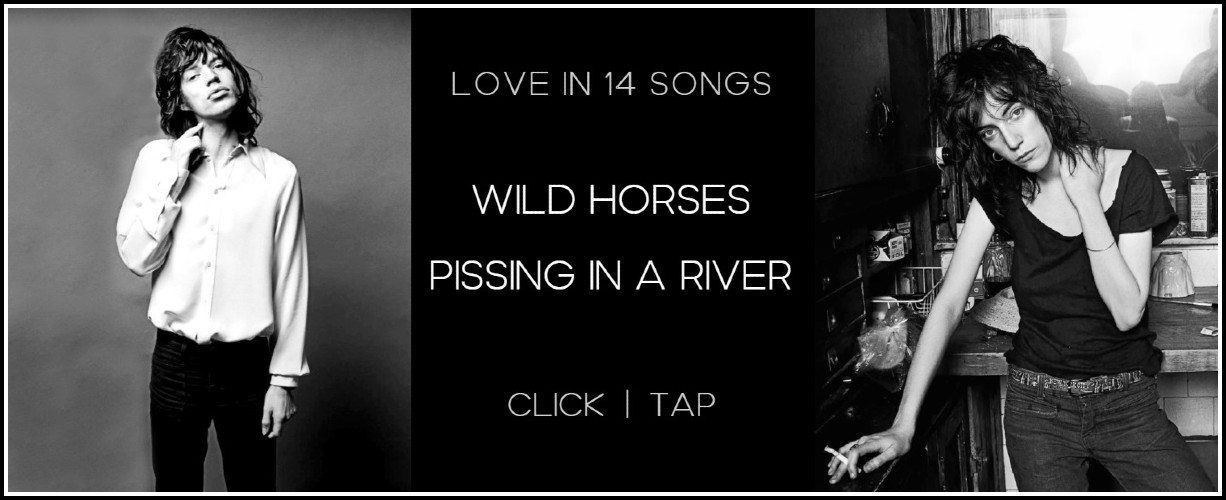
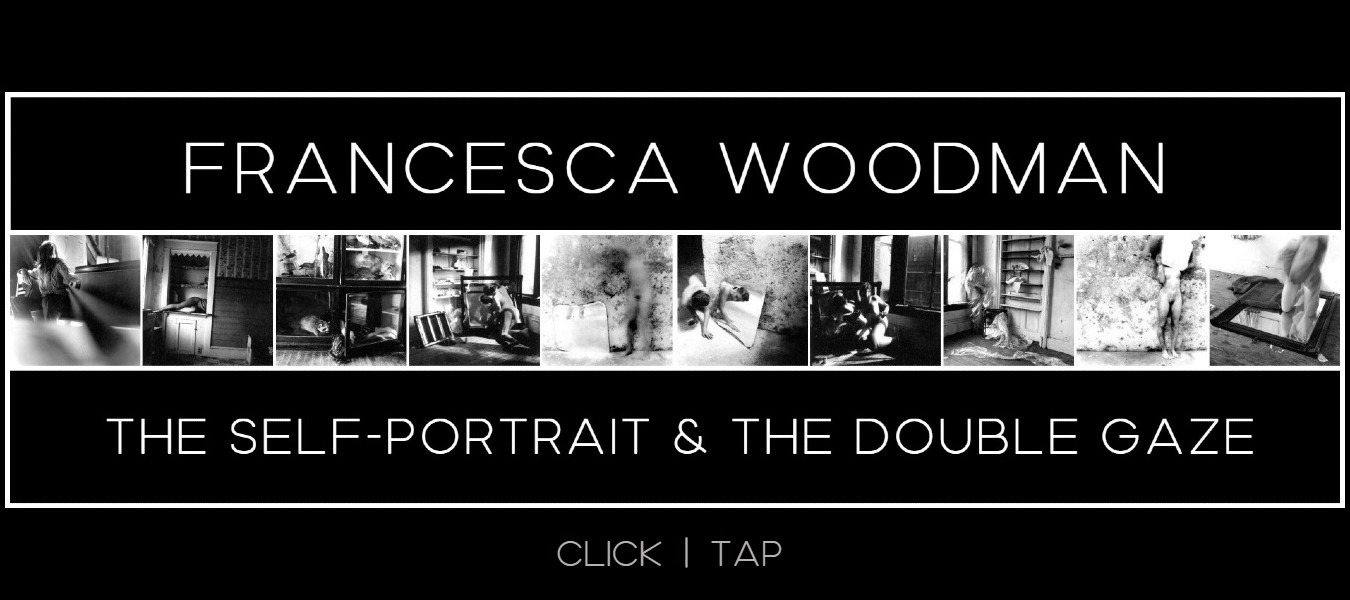


Comments
6 thoughts on “Francesca Woodman, or the Shadow of Suicide”
Amazing insightful article! Thank you!
I learned a lot from this page. You wrote about Francesca so beautifully.
In this brief moment, I have discovered Francesca and some of her work published online. It is compelling and carefully executed. Beautiful and gifted, it is a loss to all that she could not get past the adolescent angst that seems to have plagued her with self doubt.
A most illuminating reveal of Francesca. I have been working on a poem about her for the last seven years and hope to finish it for my next book this Fall
There’s a lot to be said for her negations. Not having the immediate success she envisioned, out of thwarted ambition, she instinctively knew that suicide was the solution. Her final Surrealist act. A way to be noticed after a compelling body of work. I think that what could have been is of far more interest. If she’d lived long enough to mature beyond her juvenile years.
I have an obsession with Francesca Woodman and this article is one of the most considered I’ve ever come across – and trust me; I’ve read the lot!